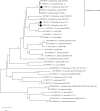Epidemiology of Chlamydia sp. infection in farmed Siamese crocodiles (Crocodylus siamensis) in Thailand
- PMID: 38008768
- PMCID: PMC10680321
- DOI: 10.1186/s13028-023-00713-x
Epidemiology of Chlamydia sp. infection in farmed Siamese crocodiles (Crocodylus siamensis) in Thailand
Abstract
Background: Although Chlamydia sp. causes widespread disease outbreaks in juvenile crocodiles in Thailand, data regarding the epidemiology, and risk factors of such infections are limited. The aim of this study was to investigate the prevalence and possible risk factors associated with Chlamydia sp. infections on Siamese crocodile (Crocodylus siamensis) farms in Thailand. A cross-sectional study was conducted from July to December 2019. Samples were collected from 40 farms across six regions in Thailand. Conjunctival, pharyngeal, and cloacal swab samples were analyzed for Chlamydiaceae nucleic acids using semi-nested PCR followed by phylogenetic analysis based on the ompA gene fragment. Risk factors of infection were analyzed using chi-square and univariate regression to calculate odds ratios.
Results: The prevalence of Chlamydia sp. infection across all regions was 65%. The ompA phylogenetic analysis showed that Chlamydia sp. detected in this study was genetically closely related to Chlamydia crocodili and Chlamydia caviae. The risk factors for infection were water source, reusing treated wastewater from the treatment pond, not disposing of leftover food, low frequency of water replacement in the enclosure of juvenile crocodiles, and lack of water replacement after the death of a crocodile.
Conclusion: The prevalence of Chlamydia sp. infection in farmed crocodiles in Thailand was 65% during the study period. Cloacal swabs were superior to conjunctival and pharyngeal swabs due to their higher sensitivity in detecting Chlamydia sp., as well as their lower invasiveness. Good management and biosecurity in crocodile farming can reduce the risk of Chlamydia sp.
Keywords: Chlamydiosis; OmpA; Polymerase chain reaction; Risk factors.
© 2023. The Author(s).
Conflict of interest statement
The authors declare that they have no competing interests.
Figures


Similar articles
-
Coinfection of Chlamydia spp. and herpesvirus in juvenile farmed Siamese crocodiles (Crocodylus siamensis) in Thailand.Vet World. 2021 Jul;14(7):1908-1914. doi: 10.14202/vetworld.2021.1908-1914. Epub 2021 Jul 25. Vet World. 2021. PMID: 34475716 Free PMC article.
-
Combined Fatal Systemic Chlamydia sp. and Aeromonas sobria Infection in Juvenile Siamese Crocodiles ( Crocodylus siamensis).Vet Pathol. 2018 Sep;55(5):736-740. doi: 10.1177/0300985818768382. Epub 2018 Apr 16. Vet Pathol. 2018. PMID: 29661119
-
Diversity and genetic characterization of Chlamydia isolated from Siamese crocodiles (Crocodylus siamensis).Acta Trop. 2024 May;253:107183. doi: 10.1016/j.actatropica.2024.107183. Epub 2024 Mar 12. Acta Trop. 2024. PMID: 38479468
-
Evidence of avian and human influenza A virus infection in farmed Siamese crocodiles (Crocodylus siamensis) in Thailand.PLoS One. 2025 Jan 7;20(1):e0317035. doi: 10.1371/journal.pone.0317035. eCollection 2025. PLoS One. 2025. PMID: 39774465 Free PMC article.
-
Molecular evidence for genetic distinctions between Chlamydiaceae detected in Siamese crocodiles (Crocodylus siamensis) and known Chlamydiaceae species.Jpn J Vet Res. 2015 Feb;63(1):5-14. Jpn J Vet Res. 2015. PMID: 25854083
References
-
- Department of Fisheries. Thailand preparing to downlist CITES appendix of Siamese crocodile from appendix 1 to appendix 2 in CITES CoP19 after the approval of the cabinet. 2022. https://www4.fisheries.go.th/local/file_document/20220711114826_1_file.pdf. Accessed 22 Oct 2022.
-
- Sariya L, Kladmanee K, Bhusri B, Thaijongrak P, Tonchiangsai K, Chaichoun K, Ratanakorn P. Molecular evidence for genetic distinctions between Chlamydiaceae detected in Siamese crocodiles (Crocodylus siamensis) and known Chlamydiaceae species. Jpn J Vet Res. 2015;63:5–14. - PubMed
-
- Inchuai R, Sukon P, Weerakhun S. Molecular detection of Chlamydia spp. and risk factors in farmed Siamese crocodile in the mid-northeastern provincial cluster of Thailand. Vet Integr Sci. 2022;20:231–245. doi: 10.12982/VIS.2022.018. - DOI
-
- Conley KJ, Shilton CM. Pathology of Wildlife and Zoo Animals. Cambridge: Academic Press; 2018. pp. 855–70.
MeSH terms
Substances
Grants and funding
LinkOut - more resources
Full Text Sources

